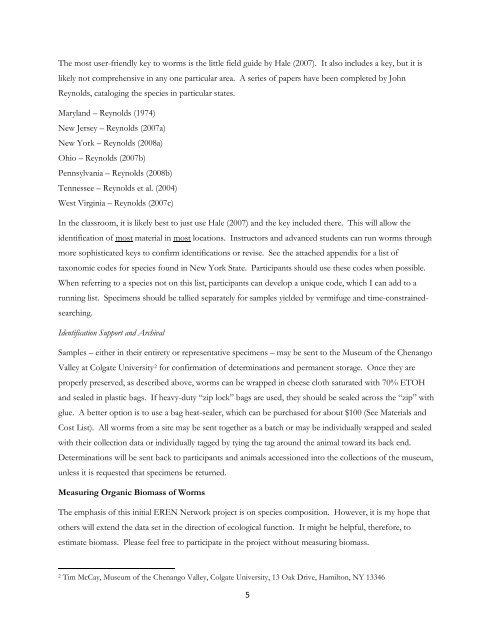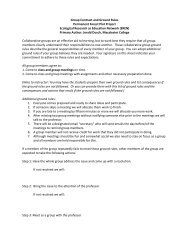EREN Worm Protocol
EREN Worm Protocol
EREN Worm Protocol
You also want an ePaper? Increase the reach of your titles
YUMPU automatically turns print PDFs into web optimized ePapers that Google loves.
The most user-friendly key to worms is the little field guide by Hale (2007). It also includes a key, but it is<br />
likely not comprehensive in any one particular area. A series of papers have been completed by John<br />
Reynolds, cataloging the species in particular states.<br />
Maryland – Reynolds (1974)<br />
New Jersey – Reynolds (2007a)<br />
New York – Reynolds (2008a)<br />
Ohio – Reynolds (2007b)<br />
Pennsylvania – Reynolds (2008b)<br />
Tennessee – Reynolds et al. (2004)<br />
West Virginia – Reynolds (2007c)<br />
In the classroom, it is likely best to just use Hale (2007) and the key included there. This will allow the<br />
identification of most material in most locations. Instructors and advanced students can run worms through<br />
more sophisticated keys to confirm identifications or revise. See the attached appendix for a list of<br />
taxonomic codes for species found in New York State. Participants should use these codes when possible.<br />
When referring to a species not on this list, participants can develop a unique code, which I can add to a<br />
running list. Specimens should be tallied separately for samples yielded by vermifuge and time-constrainedsearching.<br />
Identification Support and Archival<br />
Samples – either in their entirety or representative specimens – may be sent to the Museum of the Chenango<br />
Valley at Colgate University 2 for confirmation of determinations and permanent storage. Once they are<br />
properly preserved, as described above, worms can be wrapped in cheese cloth saturated with 70% ETOH<br />
and sealed in plastic bags. If heavy-duty “zip lock” bags are used, they should be sealed across the “zip” with<br />
glue. A better option is to use a bag heat-sealer, which can be purchased for about $100 (See Materials and<br />
Cost List). All worms from a site may be sent together as a batch or may be individually wrapped and sealed<br />
with their collection data or individually tagged by tying the tag around the animal toward its back end.<br />
Determinations will be sent back to participants and animals accessioned into the collections of the museum,<br />
unless it is requested that specimens be returned.<br />
Measuring Organic Biomass of <strong>Worm</strong>s<br />
The emphasis of this initial <strong>EREN</strong> Network project is on species composition. However, it is my hope that<br />
others will extend the data set in the direction of ecological function. It might be helpful, therefore, to<br />
estimate biomass. Please feel free to participate in the project without measuring biomass.<br />
2 Tim McCay, Museum of the Chenango Valley, Colgate University, 13 Oak Drive, Hamilton, NY 13346<br />
5




